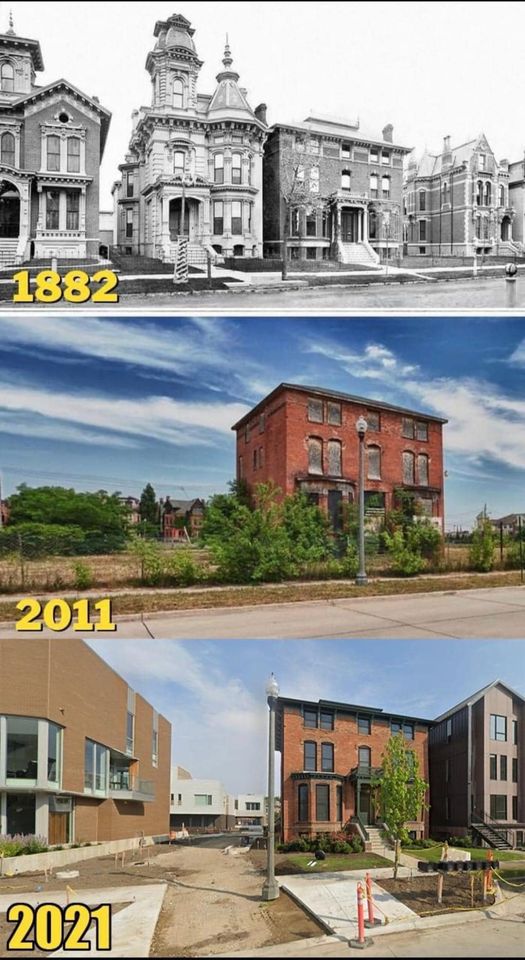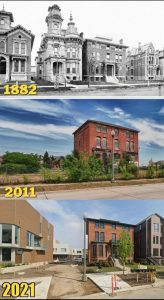
Abandoned Forgotten
Detroit, Michigan: Then vs. Now
Detroit, often referred to as the “Motor City,” has experienced dramatic changes over the last century. Once the booming heart of America’s industrial era, Detroit’s story is a tale of economic rise, urban decay, and eventual revitalization. Let’s break it down through various aspects of the city’s transformation from its peak to where it stands today.
1. Detroit’s Glory Days (Early 20th Century – 1950s)
Then: The Birthplace of the American Auto Industry
Automobile Capital: Detroit was a symbol of American industrial might. The city was home to the Big Three automakers—Ford, General Motors, and Chrysler—who dominated the global car industry. The city’s workforce was largely made up of skilled laborers working in massive auto plants.
Economic Boom: The 1920s and post-WWII years saw a booming economy. Detroit’s population reached its peak in the 1950s, reaching over 1.8 million residents. The city was a magnet for African Americans during the Great Migration, and its thriving auto industry offered jobs to people from all over the country.
Cultural and Architectural Prestige: Detroit’s downtown was filled with stunning architecture, from the Art Deco skyscrapers like the Guardian Building to the Fox Theatre, one of the grandest movie palaces of its time. The city had vibrant cultural hubs, jazz clubs, and theaters, earning it the nickname “The Paris of the Midwest.”
Great Migration & African American Empowerment: During the early 20th century, Detroit was a major destination for Black families leaving the South in search of better opportunities, contributing to the city’s rich cultural fabric, especially in music (Motown), sports, and the arts.
Notable Landmarks:
The Detroit Riverwalk (as a thriving trade and transport hub)
The Michigan Central Station (symbol of Detroit’s architectural grandeur)
Motown Records (producing iconic artists like Stevie Wonder, Marvin Gaye, and The Supremes)
2. Decline and Decay (1960s – 2000s)
Then: The Fall of Detroit’s Industrial Might
The Auto Industry Decline: Starting in the 1960s, the auto industry faced increasing competition from foreign manufacturers, labor strikes, and mismanagement. The city’s reliance on the auto industry made it vulnerable to these changes.
White Flight & Racial Unrest: Amidst economic decline, white flight from the city became rampant in the 1950s and 60s. Following the 1967 Detroit Riot, tensions between racial groups worsened, and many white families moved to the suburbs. Detroit’s population began a steady decline.
Economic Collapse: With the collapse of the auto industry, Detroit faced widespread job losses, poverty, and abandoned neighborhoods. The city’s infrastructure deteriorated, and buildings were left to rot. By the 1970s and 80s, Detroit was known for its crime rates, urban blight, and empty buildings.
The Fall of the Downtown: Once a bustling commercial center, downtown Detroit’s business district became increasingly vacant. Iconic buildings like the Michigan Central Station were left abandoned, and many areas became hotspots for vandalism and crime.
Notable Landmarks in Decline:
Michigan Central Station (abandoned and deteriorating for decades)
The Detroit Institute of Arts (facing financial cuts and threatened by city’s financial crisis)
Houses of Worship: Many of Detroit’s historic churches were left in disrepair as the population dwindled.
3. The Bankruptcy and Turnaround (2008 – Present)
Now: The Rise of Detroit’s Revival
Bankruptcy & Financial Crisis: In 2013, Detroit filed for bankruptcy, becoming the largest U.S. city to do so. At the time, the city was $18 billion in debt, with crumbling infrastructure and a shrinking tax base. The state of Michigan intervened with an emergency manager to handle the crisis. The bankruptcy was officially resolved in 2014, but the damage was extensive.
Suburban Growth & Urban Decay: As Detroit’s population declined, its suburbs, like Southfield, Troy, and Farmington Hills, saw significant growth. Meanwhile, Detroit’s once-thriving downtown and residential neighborhoods were left with abandoned houses, overgrown lots, and dilapidated commercial spaces.
Revitalization Efforts: In recent years, Detroit has started to make a comeback. Businesses and investors, including Dan Gilbert (Quicken Loans), have heavily invested in revitalizing parts of downtown. Old buildings are being restored, and Tech Startups and hip restaurants are cropping up. Many once-abandoned buildings have been repurposed into loft apartments, hotels, and office spaces.
The Detroit Riverwalk has been revitalized into a vibrant space for outdoor recreation and community events, with new parks and restaurants along the waterfront.
The District Detroit area near the Little Caesars Arena has transformed into an entertainment hub, attracting sports fans and visitors.
New Developments: New buildings like Little Caesars Arena, Corktown’s Michigan Central Station (under renovation by Ford Motor Co.), and The Shinola Hotel offer a glimpse of modern Detroit, where business, culture, and technology intersect.
Urban Farming & Community Initiatives:
Detroit has embraced urban farming and community-led initiatives, where vacant lots are being transformed into urban gardens and green spaces, helping to tackle issues of food insecurity and community development. Projects like The Detroit Black Community Food Security Network and The Detroit Garden Collaborative have become major drivers of local activism.
New Housing: Once-blighted neighborhoods are seeing a wave of new homebuyers, including artists, millennials, and young professionals who are drawn to the city’s affordable housing and creative potential. Housing developments like The Brewster-Douglass Housing Projects have been reimagined, though many abandoned spaces still remain.

Notable Detroit Landmarks: Then vs. Now
Michigan Central Station:
Then: A majestic symbol of Detroit’s past, a beautiful Beaux-Arts building, now largely abandoned.
Now: Undergoing a massive renovation by Ford Motor Co., the station is being transformed into a hub for Ford’s mobility and technology division.
The Detroit Institute of Arts (DIA):
Then: World-renowned museum, but at risk during the bankruptcy.
Now: The museum has remained open and is now part of the city’s cultural resurgence. It continues to be a focal point of Detroit’s efforts to attract both tourists and residents.
Belle Isle:
Then: Belle Isle Park was a popular, well-maintained island park in the 1950s.
Now: After years of neglect, the island has seen a resurgence, with upgrades to the Detroit Zoo, Detroit Yacht Club, and increased access to recreational areas.
Challenges Remain:
Despite the significant progress, Detroit still faces many challenges:
Poverty & Unemployment: While the city is on the mend, poverty and unemployment rates are still higher than the national average.
Housing Crisis: Many homes remain abandoned, and blight removal remains an ongoing struggle.
Crime: While crime rates have dropped significantly since the 1990s, certain neighborhoods still struggle with violence and insecurity.
Looking Forward:
The future of Detroit is one of cautious optimism. The city is on its way to becoming a hub for technology and innovation, but gentrification remains a concern as wealthier residents move in and long-time communities face displacement.
Detroit is no longer the industrial giant it once was, but its history, culture, and recent revitalization efforts have allowed it to make strides toward a more sustainable, creative, and inclusive future.
In Summary:
Then: Detroit’s heyday was a golden era of industrial might and cultural richness.
Now: Detroit faces the challenges of revitalization but is gradually reclaiming its reputation as a city of innovation and resurgence.
Detroit’s story is one of resilience, marked by both loss and renewal, and continues to evolve as a symbol of the American spirit.



